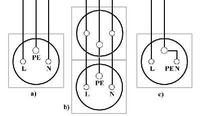Two wires are connected to the flat in which I live, that is, the whole installation is without a protective conductor - grounding.
In the kitchen, I discovered three sockets in the sockets, including one for grounding, today I felt on my skin that the sink and faucet tweaks with electricity, when I touch with my hand I feel nothing, but when I touch the inside of the wrist, I feel pinching. I took the probe and after touching the tap it lights ... I started to look for the reason where the tap is electricity and came to the fact that after disconnecting from the microwave socket, the pinching effect disappears. I also determined where the third wire came from the kitchen sockets - grounding .... someone led an additional wire in the wall and connected it to the water pipe.
It turns out that the microwave after connecting to the socket transmits current to the grounding bolt (why?) And it flies with a cable to the water pipe and if the tap pinches me, it can be similar in my neighbors.
I turned the microwave off of the socket but what to do next?
Certainly disconnect this makeshift ground from the water pipe, but do you leave the outlets without ground or bridge the ground prong with the neutral wire in the outlet?
Why, when switched on to ground, does the microwave give current to the ground prong in the socket, is it completely new, is it damaged and can I use it safely in a non-grounded installation?
In the kitchen, I discovered three sockets in the sockets, including one for grounding, today I felt on my skin that the sink and faucet tweaks with electricity, when I touch with my hand I feel nothing, but when I touch the inside of the wrist, I feel pinching. I took the probe and after touching the tap it lights ... I started to look for the reason where the tap is electricity and came to the fact that after disconnecting from the microwave socket, the pinching effect disappears. I also determined where the third wire came from the kitchen sockets - grounding .... someone led an additional wire in the wall and connected it to the water pipe.
It turns out that the microwave after connecting to the socket transmits current to the grounding bolt (why?) And it flies with a cable to the water pipe and if the tap pinches me, it can be similar in my neighbors.
I turned the microwave off of the socket but what to do next?
Certainly disconnect this makeshift ground from the water pipe, but do you leave the outlets without ground or bridge the ground prong with the neutral wire in the outlet?
Why, when switched on to ground, does the microwave give current to the ground prong in the socket, is it completely new, is it damaged and can I use it safely in a non-grounded installation?



